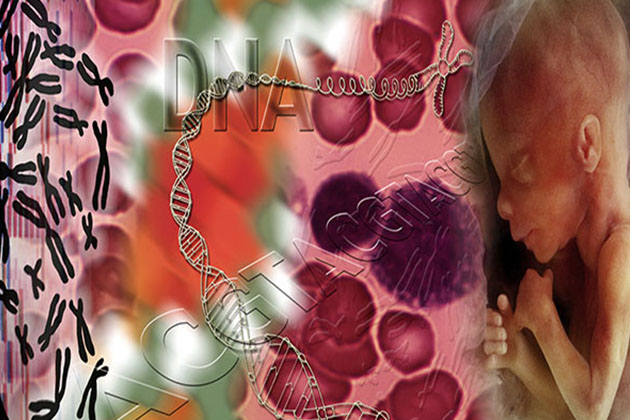Rannsókn sýnir loforð um að meðhöndla erfðasjúkdóma hjá spendýri við fósturþroska á fyrstu þremur mánuðum meðgöngu
A erfðaefni truflun er ástand eða sjúkdómur sem orsakast af óeðlilegum breytingum eða stökkbreytingum á DNA einstaklings í geninu. Okkar DNA provides the required code for making proteins which then perform most of the functions in our body. Even if one section of our DNA gets altered in some way, the protein associated with it can no longer carry out its normal function. Depending upon where this change happens either it can have a little or no effect or it might alter the cells so much that it could then lead to a erfðaefni disorder or illness. Such changes are caused by errors in DNA replication (duplication) during growth, or environmental factors, lifestyle, smoking and exposure to radiation. Such disorders are passed on to the offspring and start to occur when the baby is developing in mother’s uterus and are therefore referred to as ‘birth defects’.
Birth defects can be minor or extremely severe and may affect appearance, function of an organ and some aspect of physical or mental development. Millions of children are born annually with serious erfðaefni conditions. These defects can be detected during pregnancy as they are evident within the first three months of pregnancy when the organs are still forming. A technique called amniocentesis is available for detecting erfðaefni abnormalities in the foetus by testing amniotic fluid extracted from the uterus. However, even with amniocentesis, treating them is not possible as no options are available to make any corrections before birth of the baby. Some of the defects are harmless and require no intervention but some others can be of serious nature and may require long-term treatment or even be fatal for the infant. Some defects can be corrected shortly after birth of the baby – example within a week’s time – but mostly it is too late for treatment.
Ráðhús erfðaefni condition in an unborn baby
For the first time the revolutionary gene editing technique has been used to cure a ‘erfðaefni disorder’ in mice during foetal development in the uterus in a study by researchers at Carnegie Mellon University and Yale University. It is well established that during early development in the embryo (during first three months of a pregnancy) there are many stem cells (an undifferentiated cell type which can become any type of cell upon maturation) that are dividing at a fast rate. This is the pertinent time point where a erfðaefni mutation if corrected would reduce the impact of the mutation on embryo-to-foetal development. There are chances that a severe erfðaefni condition could even be cured and the baby is born without the unintended birth defects.
Í þessari rannsókn sem birt var í Nature Communications researchers have used a peptide nucleic acid-based gene editing technique. This technique has been used before to treat beta thalassemia – a erfðaefni blood disorder in which haemoglobin (HB) produced in the blood is reduced considerably which then affects normal oxygen supply to various parts of the body leading to severe abnormal consequences. In this technique, unique synthetic molecules called peptide nucleic acids (PNAs) (made of a combination of synthetic protein backbone with DNA and RNA) were created. A nanoparticle was then used to transport these PNA molecules along with “healthy and normal” donor DNA to the location of a erfðaefni mutation. The complex of PNA and DNA identifies the designated mutation at a site, PNA molecule then binds and unzips the double helix of mutated or faulty DNA. Lastly, donor DNA binds with the mutated DNA and automates a mechanism to correct the DNA error. The main significance of this study is that it was done in a foetus, thus researchers had to use a method analogous to amniocentesis wherein they inserted the PNA complex into the amniotic sac (amniotic fluid) of pregnant mice whose foetuses were carrying the gen stökkbreyting sem veldur beta thalassemia. Eftir eina inndælingu af PNA voru 6 prósent stökkbreytinga leiðrétt. Þessar mýs sýndu bata í einkennum sjúkdómsins, þ.e. blóðrauðagildi voru innan eðlilegra marka sem mætti túlka sem að mýsnar væru „læknar“ af sjúkdómnum. Þeir sýndu einnig aukna lifun. Þessi inndæling var á mjög takmörkuðu sviði en vísindamenn eru vongóðir um að hægt sé að ná enn meiri árangri ef sprautað var mörgum sinnum.
Rannsóknin skiptir máli vegna þess að ekki var tekið fram utan marka og aðeins æskilegt DNA var leiðrétt. Genabreytingaraðferðir eins og CRISPR/Cas9 eru þó auðveldari í notkun í rannsóknartilgangi, þær eru enn umdeildar vegna þess að þær skera DNA og framkvæma villur utan staðar þar sem þær skemma líka venjulegt DNA utan miða. Vegna þessarar takmörkunar eru þau ekki hentug til að hanna meðferðir. Að teknu tilliti til þessa þáttar, þá binst aðferðin sem sýnd er í núverandi rannsókn aðeins við mark-DNA og gerir við það og sýnir engar villur á staðnum. Þessi markvissa gæði gerir það tilvalið fyrir meðferðir. Slík aðferð í núverandi hönnun gæti einnig mögulega verið notuð til að „lækna“ aðrar aðstæður í framtíðinni.
***
{Þú getur lesið upprunalegu rannsóknarritgerðina með því að smella á DOI hlekkinn sem gefinn er upp hér að neðan á listanum yfir tilvitnaðar heimildir}
Heimildir)
Ricciardi AS o.fl. 2018. Afhending nanóagna í móðurkviði fyrir staðbundna erfðamengisbreytingu. Nature Communications. https://doi.org/10.1038/s41467-018-04894-2
***






































